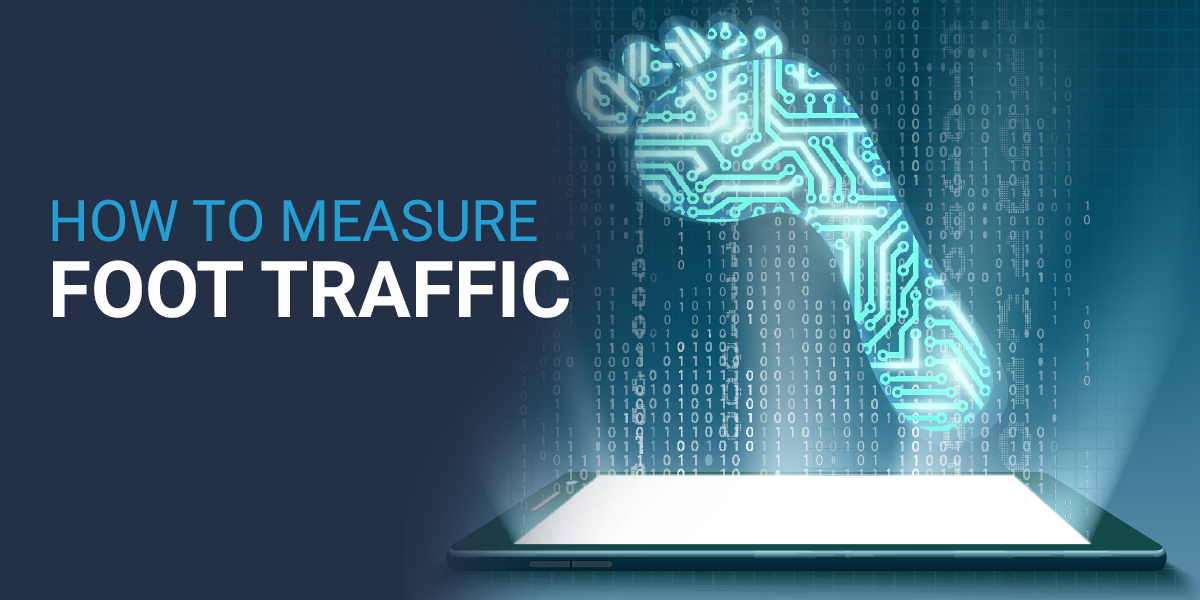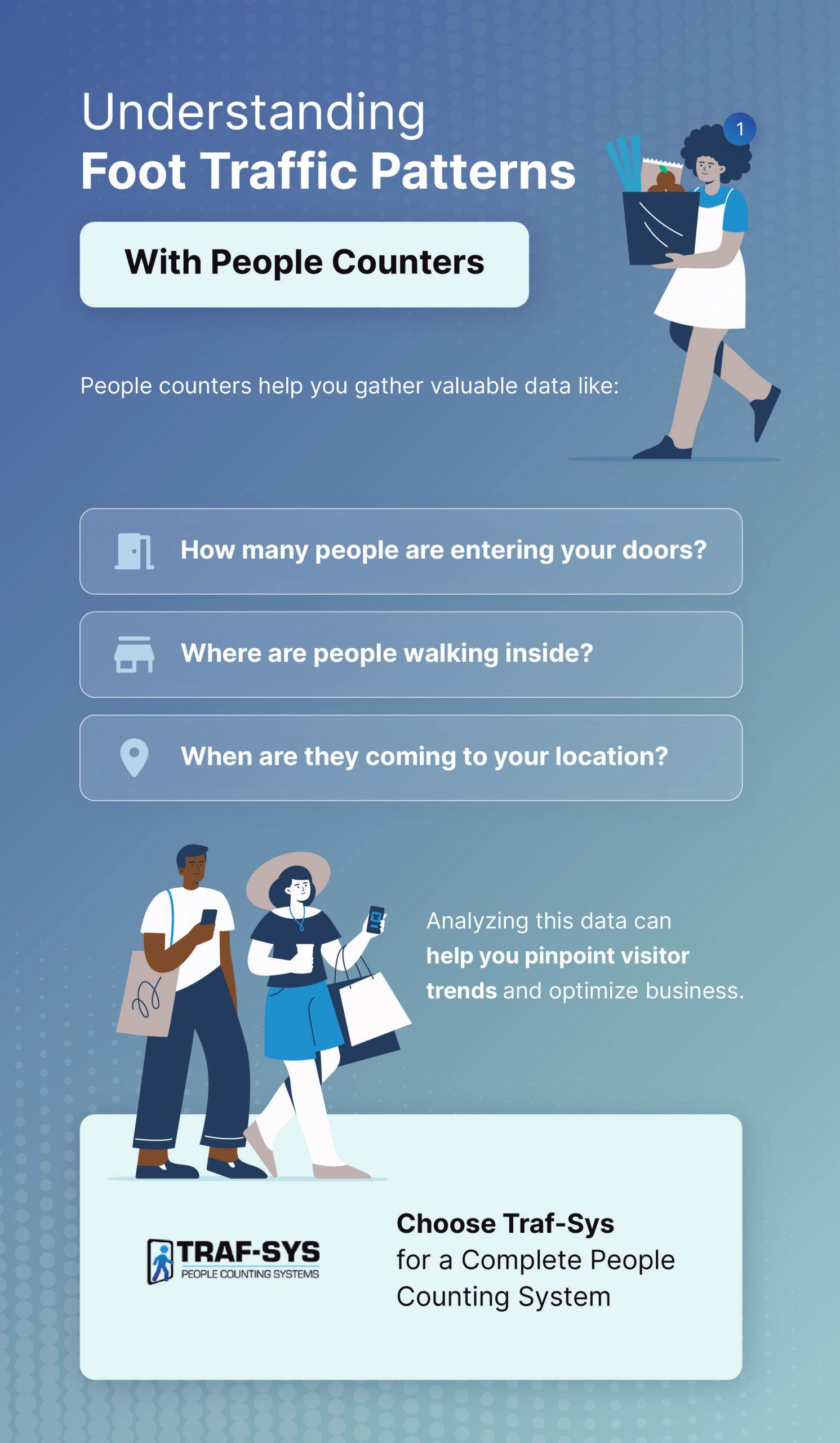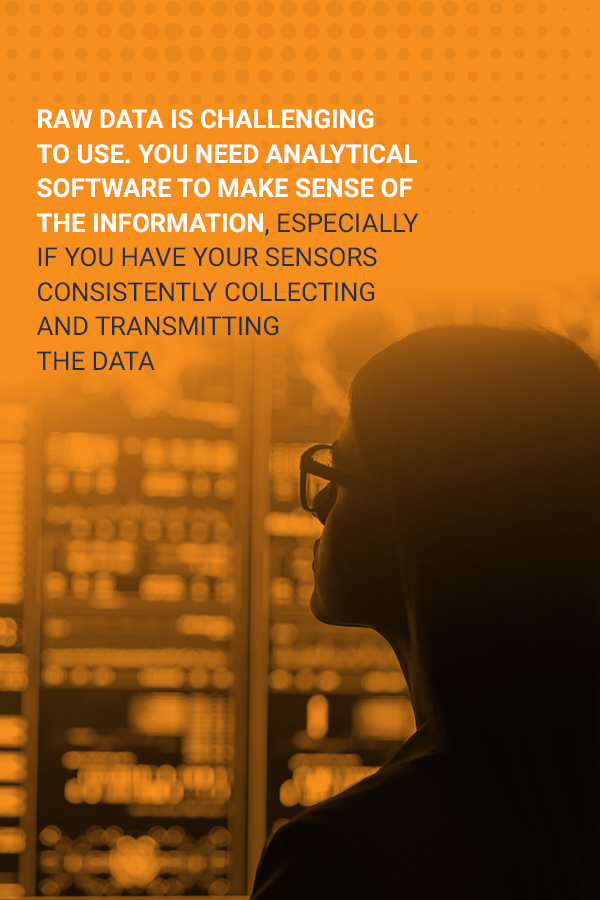

Table of Contents
Many types of businesses, including for- and non-profits, rely on people patronizing them. Without adfoot equate pedestrian traffic near your business, you may not hit the numbers you need. But getting people into the door is not the only reason you will want to evaluate foot traffic data.
Identifying pedestrian cycles gives you the information you need to optimize your operations. Whatever your sector, you will find a use for measuring traffic in the area. If you want a people counting software and hardware solution for your business, learn the best way to set it up for assessing the habits of those walking in your building.
Read the full guide or jump to a specific section:
While most associate people counting with retail, this information is vital in multiple fields, including:
1. Create Goals for Measuring Foot Traffic
2. Identify Entry and Exit Points For Data Collection
3. Select Traffic Counting Sensors
4. Choose How You Will Store or Transmit Data
5. Install Counting Sensors
6. Set Up Foot Traffic Data Collection Procedures
7. Begin Collecting Information on Foot Traffic
8. Analyze Foot Traffic Data
9. Make Decisions
How you measure pedestrian traffic depends on what you will do with the data. Setting up hardware and software for the counting process automates things so you can save your workers’ time while gathering necessary information about foot traffic. Following these steps ensures you have a setup that will accurately count people.
If you want to know how to collect foot traffic data, you need to determine your goals before creating a data-gathering strategy. What you intend to do with the information will help you choose the best hardware for counting people. Will you be:

These goals only account for some of the ends you could achieve through using sensors and software. If you have a different purpose for your business, decide what information you want to collect and use the data type and business entry points to determine the sensors you need — outdoor, thermal, image processing or bidirectional.
Where do you want to count people? While this question seems straightforward, where you install the sensor will help you choose the right model for your project. Ask yourself these questions:
Measure the entry and exit points where you want to install the sensors. Opening height and width determine how many sensors and the type you will need. The dimensions of the entryways, as well as the type of information you want to collect, will help you choose the best sensors for your people counting needs.

Consider how many entrances and exits you need to monitor to plan the number of people counting monitoring devices you need. Look at the entrance designs. Whether you have doors or an open walkway will make a difference in the sensors you use for that location.
You have two main choices for sensor position and two options for how they count. Horizontal sensors send a beam across an opening and count how many times it breaks. These may come in wireless or wired options. Overhead designs install in the ceiling and require wired network connections. These can be unidirectional or bidirectional counters. The former only counts the number of people passing through, regardless of direction. However, the latter distinguishes whether people enter or exit.
If you have a swinging door that opens outward, you can use a horizontal counter. Swinging doors that open inward can block the detection beam across people’s legs. The door funnels people through the entryway in single file, making the horizontal sensor more accurate. Ideally, only use horizontal beam devices across doorways of 15-feet wide or narrower.
For open entrances or extra-wide entry points where people can move in groups or stand in the opening, overhead sensors will give you a more accurate count. Depending on how high the ceiling is, you should plan to install at least one overhead sensor for every 11 feet of entrance width. Make sure you can get network cables and power to the overhead door sensors if you select a wired design. If your model requires a wired connection or power supply, factor that into the installation costs and time when planning.
Again, ask yourself some questions:
Additionally, you can buy server space, so you don’t need to use your servers to host the information collected by the sensors. Using a hosting service for your data will help you keep the data organized, especially if you have multiple sensors around your facility or numerous buildings with sensors installed. For instance, our Traf-Sys hosting service combines information storage and reporting into a single solution to free you from managing the database or updating software.

To ensure accurate counts, you must install the sensors correctly. The type of sensor will dictate where you must set up the device. Guard the spacing between sensors, especially overhead models, to avoid double counting or missing people who pass through the entrance.
Horizontal counters fit inside a doorframe. Install these so the door opening does not interfere with the readings. You want to count people only, not how many times the door opens. Select a site in the doorframe, so the door opens away from the sensor and does not cross the path of the counting beam. These counters have two parts that must sit directly across from each other for the laser to work. Most horizontal sensors work on batteries, but if you want a wired model, verify that you have an electrical outlet near the installation site first.
Overhead people counters install inside the upper portion of the doorframe or in the ceiling. These devices typically require hardwiring into the network to get power and transmit data. Read the instructions to see if you must set the height in the sensor or install the device at a particular level. Also, review from the instructions whether you need to set the counter to measure unidirectionally or bidirectionally.
Collecting data from your sensors depends on the type of monitors you have installed. If you have display-only counters, you will need to have one of your workers record the number each day and reset the total.
Should you prefer to have the data delivered from the sensors to your computer, you may need to add data controllers. These devices gather data from multiple sensors and can store it until you need to send it to your computer or upload to the network.
Other sensors have direct connections to the network and will upload the data to your server or a hosted server. If you choose this option, you will need network-connected sensors and a server set up to receive the data.
To collect information from base models of sensors, you will need to schedule checks of the devices to record the data and reset the counters. Checking your sensors throughout the day will help you break down the people counting data to shorter periods for more thorough information than once daily checks. Looking at these devices, especially soon after installation, gives you peace of mind that you put them into place correctly and they provide accurate information.
Even if you have a sensor that automatically uploads its data to a server, you still should check them regularly to ensure network connection and accurate people counting.
Raw data is challenging to use. You need analytical software to make sense of the information, especially if you have your sensors consistently collecting and transmitting the data.

Software, such as VisiCount, analyzes the information from your sensors and generates easy-to-understand reports. With flexible import and export options, you can give the software the information you need to read. Look over the information in a variety of formats — tables, graphs and drill down — to spot trends. See whether the day or time affected business. You can even examine if weather played a role in a rise or fall in foot traffic.
Scaling the data gives your business room to grow because you can increase the number of branches you monitor easily. Being able to examine various departments of your business can help you make decisions about:
Reports can aggregate data from multiple locations while still allowing you to access information from a particular branch or entrance. For instance, if you have a graph showing trends across all your sites, you can drill down through the data to get details for each facility. If you want to analyze the data from a single store, you can see information from each monitored entrance.
The software creates conversions, which tie the traffic information gathered into percentages to indicate the success of your business. For retailers, this means how many people entering purchased something. In libraries, it could correlate to how many people check out books. By looking over the data in terms of your business’s operations, you get a real-world means of seeing how the number of people entering affects your company.
Incorporating data hosting gives you a secure server for storing your sensor data and generating reports. With such a system, you never need to install software on a single computer. You have access to the information from anywhere, a boon to managers who travel or run multiple facilities. You also don’t have to worry about keeping your servers or managing databases to host your sensors’ information.
Once you’ve reviewed the data analytics, you need to use them effectively. Without making changes based on the data gathered, you will not use the sensors to their fullest potential.
The data you collect will help you make decisions about worker schedules, facility layouts, marketing success and more. Foot traffic data will be valuable when determining the success of your operations. Look at conversions and how changes in your advertising or selling methods influence the numbers.
After making changes based on the people counting information you collected, continue using the sensors and software to determine if your changes create the desired results. The information you gather and review will only help you as much as you use it to improve operations.
Regardless of your business sector, you cannot forego gathering information about foot traffic. People counting software and hardware are now vital tools for any company. However, setting one of these systems up from scratch poses multiple problems with hardware compatibility and accuracy of data collection. Don’t try to piece together your counting system by cobbling hardware and software on your own.
Get professional help for your people counting needs from Traf-Sys. Speak to one of our trained experts in people counting systems to get the ideal solution for your facility’s needs. Our team of experts can work with you to create a system that will help meet your data goals. Contact our experts for a customized approach to evaluating pedestrian traffic flow for your business.